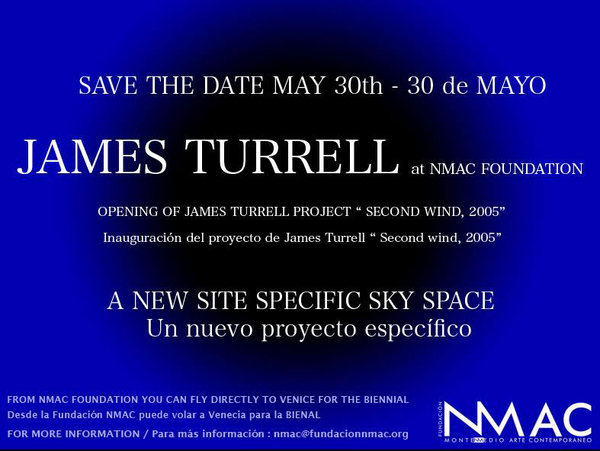James Turrell
dal 29/5/2009 al 29/9/2009
Segnalato da
29/5/2009
James Turrell
Fundacion NMAC, Cadiz
The artist inaugurates his work "Second Wind 2005", a permanent site-specific piece especially created for NMAC Foundation. It is an architectural piece, located underground, in which viewers enter an inner pyramid, via a tunnel. Curated by Jimena Blazquez Abascal.

After three years of intense work, on 30th May 2009 the public opening will be held of Second Wind 2005, a work designed by James Turrell for the NMAC Foundation. The project, curated by the Foundation’s director, Jimena Blázquez Abascal, is a site-specific piece, as are all the artworks in the NMAC Collection. Its importance lies in the fact that it is Turrell’s first permanent site-specific work produced in Spain, and his largest in Europe. Following his initial visit to NMAC in October 20006, the US artist expressed his interest in producing a project for the natural surroundings in which the Foundation stands. It was during this visit that he chose the site, and stated that “I am going to enhance something that is out there – natural light – but which we barely appreciate because, in theses, latitudes, there is no lack of it”. Second Wind 2005 is an architectural piece, located underground, in which viewers enter an inner pyramid, via a tunnel. Inside is a stone stupa, surrounded by a pool. Stupas are circular domes used in Buddhist architecture, and whose shape and position have the effect of making the cosmos appear closer. The passageway into the stupa leads to a room with a circular hole in the ceiling, open to the sky. Here, visitors can sit down and watch the changes of light “sculpted” by the artist. Turrell particularly recommends enjoying it at sunset, the moment of transition from day into night, when light is at its most intense and the colours of the sky are enhanced, altering the viewer’s perception of the sky as a space, a shape and an object. In this project, Turrell has manged to create the illusion that the sky is just within our reach, blurring the dividing line between matter and emptiness. To enter the Skyspace is to come closer to the immensity of the cosmos, making one question the difference between vision and perception.
The historical and artistic relevance of the work of James Turrell (Los Angeles, California, 1943) lies in his ability to examine the way in which we perceive light, and to isolate those features and present them to the viewer in each of his works. Instead of showing us the results of his research into the psychological perception of light, Turrell wants viewers to discover them for themselves, through their own experience. With his artworks, he offers us the chance to understand the various features of light and solar energy, and how the retina responds when faced with the changes in brightness and colour that take place throughout the day and in our planet’s two different hemispheres. His fascination with the phenomena of light is related to his personal, inward search for mankind’s place in the universe. Influenced by his Quaker upbringing, which he characterizes as having a ‘straightforward, strict presentation of the sublime’, Turrell’s art prompts greater self-awareness though a similar discipline of silent contemplation, patience, and meditation. For over three decades now, Turrell has been working on the most important project of his career, Roden Crater, an extinct volcano in the Arizona desert which his is turning into a laboratory on light perception - a celestial observatory. Alongside this major project, Turrell is also working on his exhibitions and on a number of highly complex architectural projects which are part of his series of spaces for light, known as Skyspaces.
Many of these came about as a result of his studies at Roden Crater. Turrell began his artistic career in California in the early 1960s, as one of the new group of artists working with light and space. Over the last two decades, his work has been recognized with exhibitions in major museums around the world, including the Guggenheim Museum, Whitney Museum of American Art in New York, the Museum of Contemporary Art, Los Angeles, San Francisco Museum of Modern Art, California and the Panza di Biumo Collection, Varese, Italy. The recipient of several prestigious awards such as the Guggenheim and MacArthur Fellowships, Turrell currently resides in Flagstaff, Arizona, in order to oversee the completion of Roden Crater. The crater will be opened to the public in 2011, coinciding with the retrospective of his work at the Guggenheim New York, which will later be taken on tour to eight different countries. To coincide with this project, NMAC Foundation will be issuing a catalogue, published by CHARTA. The book contains Jimena Blázquez’s interview with James Turrell, a critique on perception by Sharon Goto and William Banks, two leading US professors of psychology, and photographs by Florian Holzherr.
Press, Communications and Public Relations
Mónica Iglesias Tejera monica@fundacionnmac.org
Fundacion NMAC
Dehesa Montenmedio - Cadiz
Summer: From 10am to 2pm and 5pm to 8:30pm.
(from 1st June)
Price: €5 (under 12 free).
- 50% discount: students with a student card, pensioners, and groups of over 15 people.



